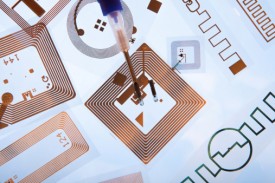RFID Is the Next-Generation Bar Code and More
Counterfeiting products has become an increasingly prevalent problem. It infringes on your intellectual property, erodes your brand, and reduces market share. Classic solutions have included bar codes and tamper-evident packaging. But with profit margins high, counterfeiters are motivated to overcome these packaging and labeling barriers, and manufacturers need to come up with more advanced solutions. Once such method is radio-frequency identification (RFID) labeling.
RFID and anti-counterfeiting packaging
RFID uses radio waves to store information on tags or devices. The system consists of two parts — a tag or transponder and a reader — that pass signals to one another. With this two-part system, some information is held back and the manufacturer must supply the additional information, through what’s called an interrogatory device, which validates the product’s authenticity.
You’re probably familiar with RFID tags used by retailers to prevent theft. A cashier must deactivate or remove the tags, or you’ll set off an alarm when you attempt to leave the store. But they are being used in other industries as well, including mobile payment, healthcare, retail, amusement parks, casinos, Redbox, and car rental. One of thier biggest uses is in drug packing. The pharmaceutical industry is rife with fake drugs, and companies are spending tens of billions of dollars each year trying to come up with packaging solutions to prevent their proliferation.
Other uses for RFID
RFID technology is being used for more than just thwarting counterfeiting. It’s being used in:
- Smart appliances — A smart washing machine can read the tags on your clothes and wash them with the correct settings.
- Product recalls — A manufacturer can track who bought the products and personally notify them of the recall.
- Product inventory — RFID helps ensure that retailers always have enough of your product in stock.
Types of RFID protection
There are several categories of security that RFID offers. Knowing which one is best for your product is important for maintaining its authenticity. Here are four common options.
- Password protection — It’s widely used but also the weakest security option. A rolling password scheme heightens the security, but the password is still vulnerable to compromise.
- Encrypted labels — Taking the time and effort to encrypt a label does little to ensure authenticity. Counterfeiters simply make a copy of it — with no need to decrypt it first.
- Challenge-response protection — Tags must authenticate with interrogators before giving any information. By managing interrogator-side secrets, manufactures can prevent counterfeiters from reading their product information.
- Double challenge-response protection — This offers the highest degree of protection. It is similar to the challenge-response method, but it adds another level of security. Both the tag and the interrogator store information to authenticate each other.
Packaging is key in trying to prevent product counterfeiting. Finding a packaging and labeling technology that offers the protection you need and that is cost-effective can be challenging. CTI can help you analyze your security needs and help you implement the best solution.

